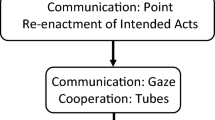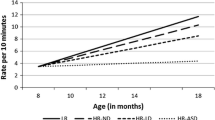Abstract
Thirty-three children with a pervasive developmental disorder (PDD) were classified to be either “aloof”, “passive”, or “active but odd” according to Wing's classification criteria (Wing & Attwood, 1987). These subgroups were compared with each other and to a control group of 33 normally developing children on the basis of behavioural measures derived from direct observation. The children were observed during an individual play session with a child psychiatrist. The comparative measures were frequency counts and transmission indices derived from sequential analysis (Steinberg, 1977; Van Hooff, 1982; De Vries, 1994). Two independent components in the communicative behaviour of the children were found to distinguish the PDD subgroups from each other in different ways: Initiatory behaviour on the one hand appeared to discriminate between all the 3 subgroups with respect to its level of occurrence as well as the effect it had on communicative acts of the child psychiatrist. Reactive behaviour on the other hand only discriminated the aloof group from the other two groups. Discrimination was seen in the frequency of this behaviour and its predictability in response to the child psychiatrist's communicative acts.
Résumé
33 enfants avec un trouble grave du comportement (PDD) furent classés en “à distance”, “passif”, “actif mais bizarre” selon les critères de classification de Wing (Wing et Attwood, 1987). C'est ce groupe était comparé entre eux et un groupe de contrôle de 33 enfants ayant un développement normal sur la base de mesure de comportement dérivé de l'observation directe. Les enfants étaient observés pendant une séance de jeu individuel avec un psychiatre d'enfants. Les mesures comparatives portaient sur le comptage de la fréquence et les indices de transmission provenant d'analyse séquentielle (Stenberg, 1977, Van Hooff, 1982, De Viries, 1994). Deux composantes indépendantes dans le comportement de communication des enfants furent trouvées, permettant de distinguer les sous-groupes entre eux selon différents moyens. D'un côté le comportement d'initiative apparut discriminant entre les trois sous-groupes selon le niveau de survenue, aussi bien que les effets sur les actes de communication du psychiatre d'enfants. Le comportement réactionnel d'un autre côté discriminait seulement le groupe à distance des deux autres groupes. La discrimination se faisait sur la fréquence de ce comportement et sa prédictabilité en réponse aux actes de communication du psychiatre d'enfants.
Zusammenfassung
33 Kinder mit einer tiefgreifenden Entwicklungsstörung wurden nach Wings Klassifikationskriterien als entweder unnahbar, passiv oder „aktiv aber eigenartig” klassifiziert (Wing & Attwood, 1987). Diese Untergruppen wurden untereinander und mit einer Kontrollgruppe, bestehend aus 33 unauffällig entwickelten Kindern, mittels der Verhaltensmessung durch direkte Beobachtung verglichen. Die Kinder wurden während einer Einzelspielsitzung mit einem Kinderpsychiater beobachtet. Vergleichende Messungen bestanden aus Häufigkeitszählungen und Transmissionsindices, die aus sequentieller Analyse ermittelt wurden (Steinberg, 1977; Van Hooff, 1982; De Vries, 1994). Zwei unabhängige Komponenten im kommunikativen Verhalten der Kinder unterschieden zwischen den beiden Untergruppen mit tiefgreifender Entwicklungsstörung auf verschiedene Weisen: Auf der einen Seite schien initiales Verhalten zwischen allen drei Subgruppen sowohl im Hinblick auf dessen Häufigkeit, als auch auf die kommunikativen Handlungen des Kinderpsychiaters zu differenzieren. Auf der anderen Seite differenzierte das reaktive Verhalten nur die als unnahbar eingestuften Kinder von den beiden anderen Gruppen. Unterschiede traten auf im Hinblick auf die Häufigkeit dieses Verhaltens und dessen Zuverlässigkeit in Abhängigkeit von den kommunikativen Handlungen des Kinderpsychiaters.
Similar content being viewed by others
References
Althaus, M., Minderaa, R.B. & Dienske, H. (1994). The assessment of individual differences between young children with a pervasive developmental disorder by means of behaviour scales which are derived by direct observation.Journal of Child Psychology and Psychiatry, 35, 333–349.
Bartko, J.J. (1976). On various intraclass correlation reliability coefficients.Psychological Bulletin, 83, 762–765.
Buitelaar, J.K., Van Engeland, H., De Kogel, C.H., De Vries, H. & Van Hooff, J.A.R.A.M. (1992). Differences in the structure of social behaviour of autistic children and nonautistic retarded controls.Journal of Child Psychology and Psychiatry, 32, 995–1015.
Buitelaar, J.K., Van Engeland, H., De Kogel, C.H., De Vries, H. & Van Hooff, J.A.R.A.M. (1992). Differences in the structure of social behaviour of autistic children and nonautistic retarded controls.Journal of Child Psychology and Psychiatry, 32, 995–1015.
De Vries, H., Netto, W.J. & Hanegraaf, P.L.H. (1993). MatMan: A program for the analysis of sociometric matrices and behavioural transition matrices.Behaviour, 125, 157–175.
De Vries, H. (1994). Descriptive measures of predictability of subsequent behaviour events from antecedent behaviour events: The information theoretic approach (in prepation).
Haberman, S.J. (1973). The analysis of residuals in cross-classified tables.Biometrics, 29, 205–220.
Lemon, R.E. & Chatfield, C. (1971). Organization of song in cardinals.Animal Behaviour, 1–17.
Millsap, R.E. & Meredith, W. (1988). Component analysis in cross-sectional and longitudinal data.Psychometrika, 53, 123–134.
Minderaa, R.B. (1989). Children with autism and related contact disorders: Diagnostic aspects.Nederlands Tijdschrift voor Geneeskunde, 133, 222–224.
Schopler, E., Reichler, R.J. & Devellis, R. (1980). Toward objective classification of childhood autism: Childhood Autism Rating Scales.Journal of Autism and Developmental Disorders, 10, 91–103.
Steinberg, J.B. (1977). Information theory as an ethological tool. In B.A. Hazlett (Ed.)Quantitative Methods in the Study of Animal Behaviour (pp. 47–74). New York: Academic Press.
Stutsman, R. (1948).Guide for Administering the Merrill-Palmer Scale of Mental Tests. Nijmegen: Berkhout.
Van Hooff, J.A.R.A.M. (1982). Categories and sequencies of behaviour: Methods of description and analysis. In K.R. Scherer & P. Ekman (Eds.)Handbook of Methods in Nonverbal Behaviour Research (pp. 362–438). Cambridge: Cambridge University Press.
Wing, L. & Gould, J. (1979). Severe impairments of social interaction and associated abnormalities in children: Epidemiology and classification.Journal of Autism and Developmental Disorders, 9, 11–29.
Wing, L. & Attwood, A. (1987). Syndromes of autism and atypical development. In D.J. Cohen & A.M. Donnellan (Eds.)Handbook of Autism and Pervasive Developmental Disorders (pp.3–19). New York: John Wiley & Sons.
Wing, L. (1988). The continuum of autistic characteristics. In E. Schopler & G. Mesibov (Eds.)Diagnosis and Assessment in Autism (pp.91–110). New York: Plenum Press.
Author information
Authors and Affiliations
Rights and permissions
About this article
Cite this article
Althaus, M., Renk, M., Minderaa, R.B. et al. Initiatory and reactive behaviour in young children with a pervasive developmental disorder: Two independent components in communicative behaviour for distinguishing subgroups. European Child & Adolescent Psychiatry 3, 242–254 (1994). https://doi.org/10.1007/BF01978113
Issue Date:
DOI: https://doi.org/10.1007/BF01978113




